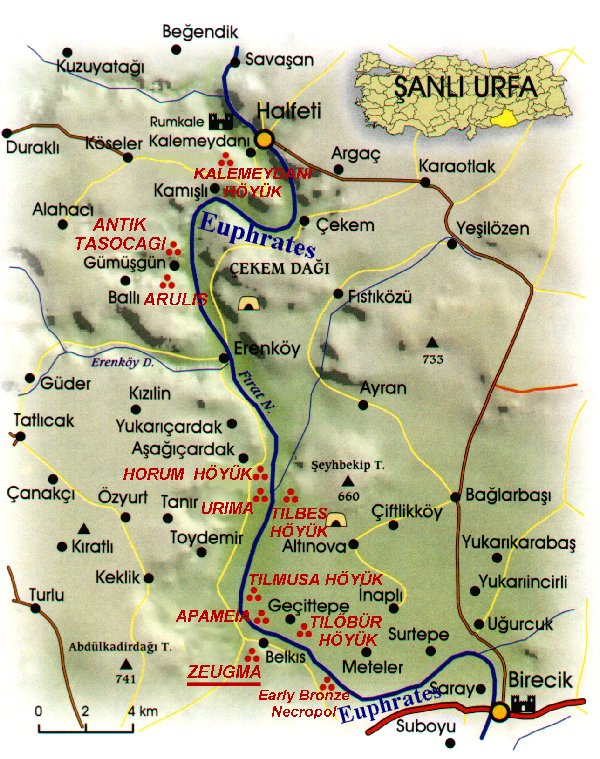ZEUGMA lies on the EUPHRATES river, which served as a link between ANATOLIA and MESOPOTAMIA from the earliest times.It is near the village of BELKIS 10 km. east of NISIBIS (Nizip) in the province of GAZIANTEP. Zeugma and Samosata (today known as Belkis and Samsat respectively) were situated at the two easiest points for crossing this great river
In particular, this route was used to bring timber from the AMANUS and TAURUS mountains to the first literate, urban civilizations of Southern Mesopotamia and probably by Assyrian traders in metals passing to and from their outpost at Kultepe in Central Anatolia.

CARCHEMISH, an important state following the fall of the HITTITE EMPIRE to the "Peoples of the Sea" in the 12th century BC, lies just 30 km downstream, on the present border between TURKEY and SYRIA. This city played a dominant role in the area until it fell to the ASSYRIANS, probably in the 9th century BC.
The city of ZEUGMA - or rather two cities on each side of the river, SELEUCEIA and APAMEA - was founded in 300 BC by SELEUCUS I NICATOR (312-281 BC), one of Alexander´s generals who had been made satrap of Babylon.Twin cities he had established here: Apameia on the east bank, named after his Persian born wife APAMA, and Seleukeia on the west bank, named after himself. Seleukeia was later renamed Zeugma, and became one of the four major cities of the kingdom of COMMAGENE.
It was to guard what had become the principal crossing point of the river Euphrates for those passing from the Western Mediterranean world to the Eastern satrapies of the old ACHAEMENID EMPIRE, conquered by Alexander in 331 BC.
 Like many other such foundations, the role of Zeugma which means "link" in Greek, or "bridge", was to protect the communications of the Seleucid Empire which stretched from the Mediterranean Sea, near its Western capital of ANTIOCH, to INDIA. Like many other such foundations, the role of Zeugma which means "link" in Greek, or "bridge", was to protect the communications of the Seleucid Empire which stretched from the Mediterranean Sea, near its Western capital of ANTIOCH, to INDIA.
It lies close to the point at which the river emerges from its gorge in the foothills of the Taurus mountains.
In the second and first centuries BC, ROME gradually came to supplant the Seleucid Empire in the West, but the PARTHIAN KINGDOM in the East also saw itself as a successor to Alexander´s GREEK EMPIRE. The river Euphrates became the frontier between Rome and Parthia, rivals for control of the East and the only two "Great Powers" in conflict during the first centuries of our era.
Zeugma became important both as a military base, home for one of only three legions on the Eastern frontier, but also as a trading city on the "Silk Route" from China to the West. As the Roman empire was extended to include Mesopotamia in the fourth century the city lost its importance as a frontier post, but its wealth increased and many fine mosaics from the third and fourth centuries have been found.Its strategic position led to its rapid development.After the region came under Roman rule the Scythian Legion (Legio Scythica) was stationed here, as a result of which the city gained still greater importance. For two centuries the city was home to high ranking officials and officers of the Roman Empire, who brought their families, advisors, slaves, and a sophisticated cultural life. As a city of both military importance and a vital commercial centre between East and West, Zeugma enjoyed its golden age in the 1st and 2nd centuries AD
 Early Parthian raids sacked the city on several occasions and the whole frontier was unstable throughout the Roman period, but Syria as a whole gained a remarkable prosperity.In 252 AD the renowned SASSANID ruler SHAHPUR I (241-272) laid siege to DURA and captured the city. Archaeological evidence shows that the Sassanids went on to burn and raze Zeugma around 252 .Even after the Sassanian Empire (successor to that of the Parthians) had pushed back the BYZANTINEs into Anatolia, Zeugma remained important as the seat of a bishopric. Early Parthian raids sacked the city on several occasions and the whole frontier was unstable throughout the Roman period, but Syria as a whole gained a remarkable prosperity.In 252 AD the renowned SASSANID ruler SHAHPUR I (241-272) laid siege to DURA and captured the city. Archaeological evidence shows that the Sassanids went on to burn and raze Zeugma around 252 .Even after the Sassanian Empire (successor to that of the Parthians) had pushed back the BYZANTINEs into Anatolia, Zeugma remained important as the seat of a bishopric.
Population and wealth of all Northern Syria and Mesopotamia however fell drastically following the Arab victories of the seventh century over both Byzantium and Sassanid Persia.
In succeeding centuries, Arabs, Turks, Armenians, Mamluks, Crusaders and Kurds all fought over this area. Certain cities - such as Aleppo and Edessa (now Urfa) retained their importance, but Zeugma was largely forgotten when the principal Euphrates crossing moved downstream to Birecik in the Middle Ages. |





